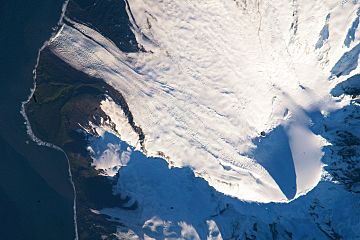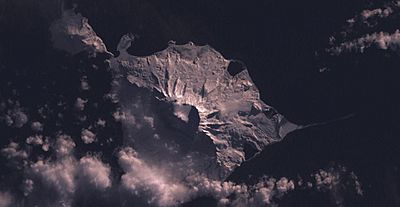Big Ben (Heard Island) facts for kids
Quick facts for kids Big Ben |
|
|---|---|

Satellite image of the southern tip of Heard Island. Cape Arkona is seen on the left side of the image, with Lied Glacier just above and Gotley Glacier just below. Big Ben and Mawson Peak are seen at the lower right side of the image.
|
|
| Highest point | |
| Elevation | 2,745 m (9,006 ft) |
| Prominence | 2,745 m (9,006 ft) |
| Listing | Country high point Ultra |
| Geography | |
| Location | Heard Island, Australia |
| Topo map | RAN Heard Island 291 |
| Geology | |
| Age of rock | Quaternary |
| Mountain type | Stratovolcano |
| Last eruption | 2012 – ongoing (as of 11 June 2019) |

Big Ben is a volcanic massif that dominates the geography of Heard Island in the southern Indian Ocean. It is a stratovolcano with a diameter of about 25 km (16 mi). Its highest point is Mawson Peak, which is 2,745 m (9,006 ft) above sea level. Much of it is covered by ice, including 14 major glaciers which descend from Big Ben to the sea. Big Ben is the highest mountain in Australian Territory, except for those claimed in the Australian Antarctic Territory. A smaller volcanic headland, the Laurens Peninsula, extends about 10 km (6 mi) to the northwest, created by a separate volcano, Mount Dixon; its highest point is Anzac Peak, at 715 m (2,346 ft).
Big Ben has been known under a variety of names throughout its history, including Big Ben Peak, Old Ben Mountain, Emperor William Peak and Kaiser Wilhelm-Berg.
Volcanic activity
Volcanic activity at the cone has been known since 1881. An eruption occurred in 1993. Satellite images detected eruptions during 2000. On 2 February 2016, observations from Atlas Cove, 15 km (9 mi) northwest of Mawson Peak, showed plumes up to 1 km (3,300 ft) high over the volcano. Satellite images showed hotspots at various times from 2003 to 2008, and during September 2012. A further eruption was reported on 2 February 2016, and was recorded by scientists who happened to be in the area on an expedition. Big Ben does not endanger humans because Heard Island is uninhabited.
Big Ben is in a remote location, and without regular observation it is possible that eruptions have occurred at other times.


